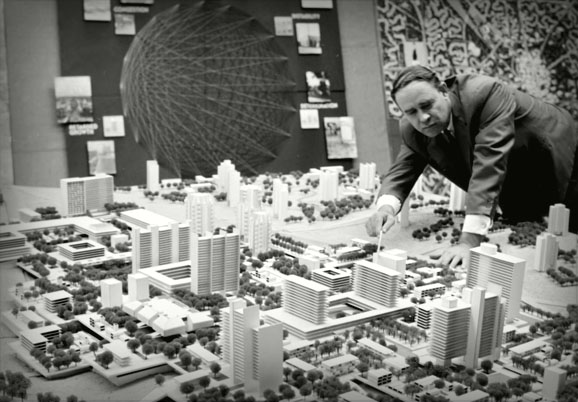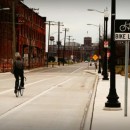PONTIAC—Part parking garage, part elevated park and amphitheater, the Phoenix Center — if Mayor Leon Jukoswki and Emergency Manager Louis Schimmel have their way — will soon be razed.
Conceived in the 1960s and built in 1980, the structure was the cornerstone of an "urban renewal" scheme that leveled neighborhoods, buried the Clinton River, and isolated the central business district from the surrounding community, creating what Oakland County planners now call "a strangled downtown."
"It was idiotic," Jukowski told the Oakland Press last year, "to cut off Woodward Avenue [from downtown] ... a perfect example of urban planning gone wrong."
But the Phoenix Center, as it now stands, was only Phase One of a sprawling, 27-acre complex — an ambitious plan to remake the entirety of downtown Pontiac — that never came to fruition.
The Pontiac Plan, as it was called, would have used a combination of federal and local funding to erase many of the downtown's existing buildings, starting from scratch with a network of interconnected structures that would include office buildings, apartment towers and retail, along with a museum, hotel, landscaped parkland and more.
Remarkably, everything was to be elevated — connected by open-air, pedestrian plazas built atop massive, three-level parking garages straddling the downtown street grid.
The plan was devised in the late 1960s by architect C. Don Davidson and University of Detroit architecture Dean Bruno Leon, and formally adopted by city government over the following decade.
"Main Street shopping is antiquated," Davidson and Leon declare in a document describing the plan, envisioning in its place a "platform city" of "megastructures" based upon a foundation of overabundant parking.
Paradoxically, the very plan that is now blamed for cutting Pontiac's downtown off from the surrounding community had originally been described by its creators as "a promise for the rebirth of humaneness in our urban center." Cars and pedestrians, Davidson and Leon assert, are "incompatible as long as they are permitted to operate on the same horizontal plane." If "streets and parking are allowed their space underneath the platforms," they argue, "towns [can be] given over entirely to landscaped areas open to the sky."
By its design, however, the Pontiac Plan was to be entered solely by automobile. A potential link to the city's rail depot was relegated to the development's periphery, and is described only in a footnote: "facilities to be provided by Grand Trunk Railroad." Pedestrian access, moreover, was not provided at all, as the plan allowed for no connection to Pontiac's surrounding residential neighborhoods. As Jukowski now laments, the four-lane highway which surrounds the central business district is, as far as pedestrian access is concerned, "as good as a river."
Although the Pontiac Plan was never realized, its insular, drive-in design is not without precedent.
During the 1960s and especially the 1970s, a number of "cities within cities" of one form or another were constructed in urban areas throughout North America. Complexes such as the Houston Center in Houston, Texas are located at street level yet present blank walls to the surrounding streets; Detroit's Renaissance Center was, at the time of its construction, separated from the rest of the city by a concrete berm several stories high. Almost all of its visitors entered through a parking garage. While the Renaissance Center's contribution to the city's economy is debatable, it has certainly failed to contribute to the city's streetscape.
Perhaps the only (actually built) development comparable to the Pontiac Plan is the Minneapolis Skyway System, a network of enclosed, second-floor pedestrian crossings that connects a total of 64 blocks within that city. Although the system deserves credit for sheltering pedestrians during the cold winter months and for doubling the amount of walkable retail space downtown, it, too, has been criticized for creating an environment that is "two-tiered" in far more than just a spatial sense.
Geographer Bill Lindeke accuses the system of favoring, by design, pedestrians who arrive via parking garage over those who are transit-dependent or who approach on foot from elsewhere in the city. Furthermore, Lindeke argues, "shifting the population of downtown office workers off the streets and sidewalks makes it easier to justify auto-oriented design features" at street level.
Auto-oriented design, however, is a hallmark of urban renewal-era planning, the price of which our urban centers are still paying to this day.
Demolition of the Phoenix Center is presently on hold, pending the outcome of a lawsuit by adjacent building owners who use the enclosed parking structure as a selling point for tenants. Still, Schimmel cites the $175,000 annual maintenance cost for the structure as cause for its demolition, and Jukowski promises, "I am definitely going to reopen Woodward into the downtown,” according to the Oakland Press.
Meanwhile, a federal grant has enabled Oakland County planners to conduct a Downtown Pontiac Transportation Assessment, examining ways to better integrate the central business district with the rest of the city. The assessment recommends converting the entire Woodward Loop to two-way traffic, leaving space for an on-road bicycle track and on-street parking. It also recommends restoring much of downtown's street grid.
In 1980, while the Phoenix Center was under construction, urban planner William H. Whyte's Street Life Project was completing a major overhaul of New York City's commercial zoning ordinance, emphasizing pedestrian amenities such as street-level plazas, trees, water, and "sittable space." According to Whyte, "the street is the river of life for the city" and something to be embraced rather than feared. To paraphrase Whyte: the best urban spaces are those that invite us not to escape from the street, but to partake in it.
[The Pontiac Plan is described in Bruno Leon and Associates (1970): "An Environmental Analysis of a Central Business Area." Only two copies remain, and are housed at the Library of Michigan in Lansing.]
Read and comment on the Downtown Pontiac Transportation Assessment










